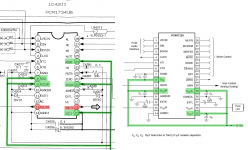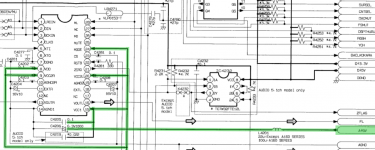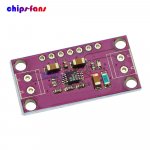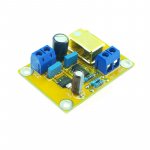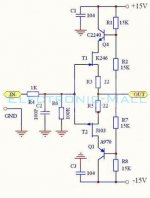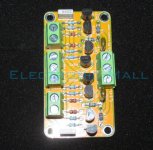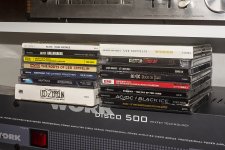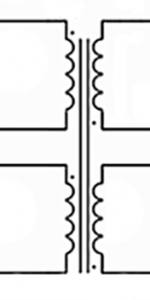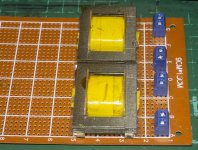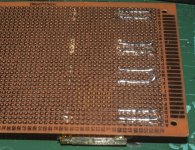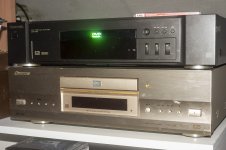You are not the first to have such an experience. What you will find if you keep listening is that all modern dacs do not the sound the same. That is true despite those people who repeat stories having the superficial appearance of science about why modern dacs must sound the same.
Well, I think the very good sound quality of this Pioneer is down to it having two good DAC chips working as a pair, with an analog output stage consisting of just one NE5532 per channel performing I/V conversion and isolated power supplies for the DACs and the NE5532s. Most players have much less good power supply arrangements and a load more parts in the output stage to muddy up the sound. I've looked at loads of service manuals for lots of different CD and DVD players today and none of them have anything like as nice an audio section as this Pioneer, with the exception of the Pioneer DV-717 which has a similar design but with a pair of Burr-Brown PCM1752 DACs.
Last edited:
After studying the SM further, the PCM1734 in the Panasonic is a V out DAC like the PCM1732, they have similar but not identical pinouts and I expect they are very similar chips.
The datasheet for the PCM1732 suggests having nothing in the output stage other than a LPF to get rid of anything above 20kHz.
So now I'm wondering what I can do with the output stage of the Panasonic, I'd like to get rid of both of those NJM4580M opamps . Would just using a single high quality capacitor work or do I really need a LPF?
One thing I'm confused about is the voltage of the output, the PCM1732 datasheet says it is 0.56V, so does there need to be some gain in the analogue output stage to increase it to the 2v of line level?
The datasheet for the PCM1732 suggests having nothing in the output stage other than a LPF to get rid of anything above 20kHz.
So now I'm wondering what I can do with the output stage of the Panasonic, I'd like to get rid of both of those NJM4580M opamps . Would just using a single high quality capacitor work or do I really need a LPF?
One thing I'm confused about is the voltage of the output, the PCM1732 datasheet says it is 0.56V, so does there need to be some gain in the analogue output stage to increase it to the 2v of line level?
Attachments
Last edited:
It depends if you like your audio to have jagged edges. You could always cut the trace going to the opamps or remove the first electrolytic caps at the dac outputs and connect your own high quality film caps there. You may not end up with much bass though unless you buffer it with a high input impedance buffer of some kind or else maybe use a huge cap. Anyway, you can try it and see if the resulting sound is to your liking. You could also revise the output stage to use *much* better opamps, bypass caps, DC blocking caps, etc., and maybe you will get the dac working well enough that you can start to notice the problem with its jittery clock, etc. As is, such things may be masked by other problems with the existing output stage 🙂
Yeah, I also think I need to provide the DAC chip with it's own isolated power supply, I have one of those little LT3042 boards, I could probably use that. I was thinking of adding a small toroidal transformer and using it to power some isolated supplies, one for the DACs, one for the analogue output stage, one for a clock circuit. I have that little 16.9kHz clock board I showed in an earlier post so I might as well use it. I've got plenty of caps in my stash to use to improve things, I was thinking judicious use of OSCONs and tantalums might help a bit.
I realise I'm doing a bit of turd polishing here, but I'm treating this as a learning experience to develop the skills and experience to be able to build better things later.
BTW, how huge would a cap need to be to buffer and still have bass?
Would a JFET buffer be suitable? I happen to have one of those sat here.
I have loads of JFETs so I could build a different buffer, I have a load of Toshiba 2SK30A which have low noise like the 2SK170 but a lot less gain, which shouldn't be an issue in a buffer I think?
I realise I'm doing a bit of turd polishing here, but I'm treating this as a learning experience to develop the skills and experience to be able to build better things later.
BTW, how huge would a cap need to be to buffer and still have bass?
Would a JFET buffer be suitable? I happen to have one of those sat here.
I have loads of JFETs so I could build a different buffer, I have a load of Toshiba 2SK30A which have low noise like the 2SK170 but a lot less gain, which shouldn't be an issue in a buffer I think?
Attachments
Last edited:
Roughly speaking, a fet buffer has pretty high input impedance so the coupling cap value could be more small-ish.
(The corner frequency is where Xc magnitude = R, assuming resistive input impedance)
(The corner frequency is where Xc magnitude = R, assuming resistive input impedance)
Last edited:
I've been looking at JFET buffer circuits and there are loads of different ones, so I'm not at all sure what to use, whether I need the buffer to have gain or not. So much to learn, but learn I shall.
The largest polypropylene caps I have are 40uF, the largest paper in oil are 10uF, I have a few smaller ones too.
The largest polypropylene caps I have are 40uF, the largest paper in oil are 10uF, I have a few smaller ones too.
Look for a buffer design that minimizes output DC offset. If zero offset (or close enough) is not achieved then you may still need a big DC blocking cap.
Interesting reading Ian. I've just this last week been looking at Pioneer dvd players. The lampizator guy rates one particular one, as used by Goldmund. A very good spdif signal apparently. I'd been considering using as a transport but your comments have piqued my interest once again and to try the internal dac too. Dv737 are about £70 on ebay so maybe I'll soon be adding one to my pile of Marantz! 717 are even cheaper.
I used those Chinese 3 pin tps7a4701 type regs to replace the 79xx/79xx regs in my CA Dacmagic. And added a wima 0.1 close to the opamp rails. Improvement was massive. Single biggest step up I've ever heard. Not sure if it was the caps or the regs....or both!
Looks like there should be plenty of room in those higher end Pioneers with the fairy tall chassis, for adding extra power supplies.
I used those Chinese 3 pin tps7a4701 type regs to replace the 79xx/79xx regs in my CA Dacmagic. And added a wima 0.1 close to the opamp rails. Improvement was massive. Single biggest step up I've ever heard. Not sure if it was the caps or the regs....or both!
Looks like there should be plenty of room in those higher end Pioneers with the fairy tall chassis, for adding extra power supplies.
I see the dac chips all share the same 5v supply so I guess there may be mileage in separating the AVDD and DVDD
Hiya Jim
I must have looked at 20 or more service manuals yesterday, examining what DAC chips and analogue output stages the various players had and nothing else apart from one Yamaha DVD player came close to the Pioneer 737 and 717, even the TOTL Sony S7000 was much inferior, a single DAC chip without local regulated supply and an OPA2134 as the output stage.
I'm thinking of buying another 737 or 717 to tweak, keeping the one I have in stock form as it will be in daily use playing CDs.
Every DAC chip I have seen uses 5V so I think using a local regulated supply is the way to go, either an ultra-low noise reg like the LT3042 or a discrete superegulator. I'd be very interested to know what you think and implement as I'm very much a beginner and might be talking out of my rear end...
I've been reading about various buffers to the point my head hurts. I have found this info from Calvin which fits with what Mark was saying about bass and caps, given I listen to mostly things like ACDC, Led Zeppelin, Queen etc. I definitely need the power and slam:
"As for the Buffer I´d say that a simple JFET Buffer in B1 or similar style tends to sound a bit ... well delicate, feathery.
They can offer a lot of Detail and lowlevel resolution and give a natural impression, well suited to classical and intimate Music.
With vastly oversized Caps close to the JFETs Bass performance improves, but these circuits will probabely never become HellsAngels.
If You want power and slam look for something different, for example the Calvin-Buffer might just be right, if You want the filigrane and the power at the same."
I must have looked at 20 or more service manuals yesterday, examining what DAC chips and analogue output stages the various players had and nothing else apart from one Yamaha DVD player came close to the Pioneer 737 and 717, even the TOTL Sony S7000 was much inferior, a single DAC chip without local regulated supply and an OPA2134 as the output stage.
I'm thinking of buying another 737 or 717 to tweak, keeping the one I have in stock form as it will be in daily use playing CDs.
Every DAC chip I have seen uses 5V so I think using a local regulated supply is the way to go, either an ultra-low noise reg like the LT3042 or a discrete superegulator. I'd be very interested to know what you think and implement as I'm very much a beginner and might be talking out of my rear end...
I've been reading about various buffers to the point my head hurts. I have found this info from Calvin which fits with what Mark was saying about bass and caps, given I listen to mostly things like ACDC, Led Zeppelin, Queen etc. I definitely need the power and slam:
"As for the Buffer I´d say that a simple JFET Buffer in B1 or similar style tends to sound a bit ... well delicate, feathery.
They can offer a lot of Detail and lowlevel resolution and give a natural impression, well suited to classical and intimate Music.
With vastly oversized Caps close to the JFETs Bass performance improves, but these circuits will probabely never become HellsAngels.
If You want power and slam look for something different, for example the Calvin-Buffer might just be right, if You want the filigrane and the power at the same."
Attachments
I forgot that back in 2018 I already went through the process of modifying the B1 buffer to work in a DAC output stage:
Modify B1 Buffer for DAC output stage
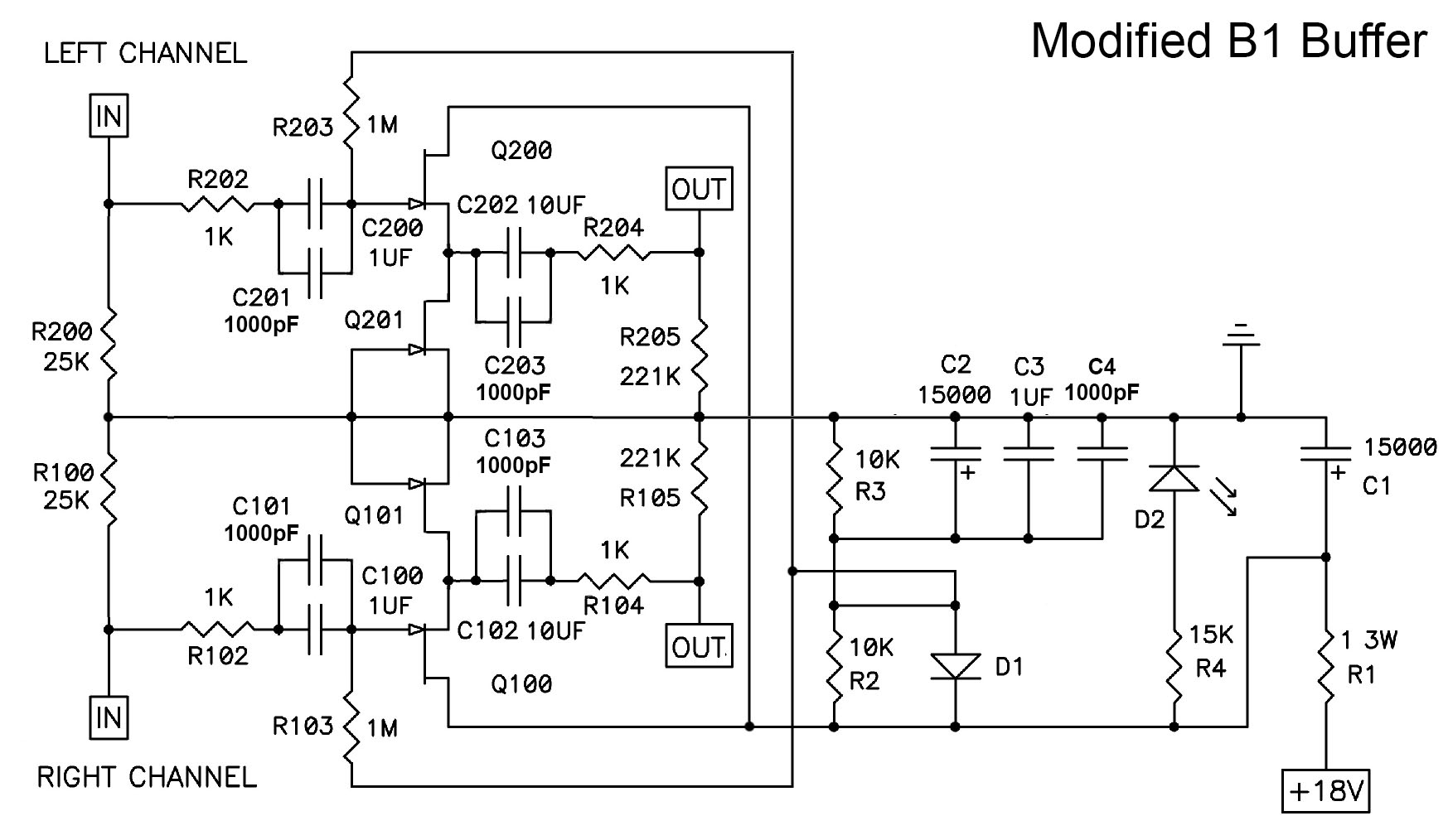
I could build this B1 variant, I have the parts, but I'm concerned it will not have enough bass, lack the power and slam etc. Maybe I can remedy that with adding caps? However, I probably should follow Calvin's advice and look at a different buffer design.
Modify B1 Buffer for DAC output stage
I could build this B1 variant, I have the parts, but I'm concerned it will not have enough bass, lack the power and slam etc. Maybe I can remedy that with adding caps? However, I probably should follow Calvin's advice and look at a different buffer design.
Last edited:
If you want deep bass you might need to ditch the output caps and servo the output to get rid of any offset. For that it would need bipolar supplies. Servo design can be tricky though; done improperly it can hurt the sound. Another way is to use big electrolytic output coupling caps, say, 470uf Panasonic FM (then give them some time to 'burn in,' possibly a few weeks), but it won't sound as clean as film caps. Yet another way is to use matched jfets similar to your schematic but with bipolar supplies. If the fets are matched well enough you can adjust the DC offset by adjusting the operating current (adjusting the current source output). You still might find you need a servo to fine tune it.
EDIT: Then again, its possible to get pretty darn good sound from modern opamps such as OPA1612 or OPA1656. Bipolar supplies and rolled foil film bypass caps. R-core transformer with separate secondary windings (no center taps). In that case the opamps can be used to remove the DC offset. This whole thing is still turd polishing, of course 🙂
EDIT: Then again, its possible to get pretty darn good sound from modern opamps such as OPA1612 or OPA1656. Bipolar supplies and rolled foil film bypass caps. R-core transformer with separate secondary windings (no center taps). In that case the opamps can be used to remove the DC offset. This whole thing is still turd polishing, of course 🙂
Last edited:
Well, I want John Bonham to sound as he should, so plenty of 'power and slam' is required methinks. 🙂
I'm keen on simplicity as I lack the experience to do anything complex, so maybe I might just be best off using a good opamp.
The variety of options is hurting my brain, to be honest, I'm finding the learning curve a bit steep.
What about using a pair of 1:1 transformers? I ask because I happen to have a pair of them I salvaged from a PA amp I stripped for parts and Sowter recommends using 1:1 trafos with V out type DACs.
I'm keen on simplicity as I lack the experience to do anything complex, so maybe I might just be best off using a good opamp.
The variety of options is hurting my brain, to be honest, I'm finding the learning curve a bit steep.
What about using a pair of 1:1 transformers? I ask because I happen to have a pair of them I salvaged from a PA amp I stripped for parts and Sowter recommends using 1:1 trafos with V out type DACs.
The transformers probably won't like DC current in the windings, which is what will happen if there is no DC blocking cap. If there is a cap, then it may need to be pretty big depending on the load the transformer presents to the dac output. That loading factor will depend in part on what is connected to the transformer output. However, if someone makes transformers designed to work with this type of dac chip, then that might be a reasonable solution. Regarding the transformers you have now, seems doubtful a Sowter line level signal transformer was designed for tolerance of DC on the windings. What does the transformer data sheet say?
Here's the Sowter page on trafos for DACs;
DAC I/V CONVERSION OUTPUT TRANSFORMERS
This is the 1:1 trafo they suggest for V out DACs:
SOWTER TYPE 3603 Balancing transformer
DAC I/V CONVERSION OUTPUT TRANSFORMERS
This is the 1:1 trafo they suggest for V out DACs:
SOWTER TYPE 3603 Balancing transformer
Ian, you're in good hands with Mark giving you advice.
I know very little about buffers/ output stages.
I won a 'for parts' DV717 today for £28 delivered. Listed as having an intermittent dvd read error. Hopefully its ok with CD. Otherwise I have a decent chassis for sonething, maybe I could hack it and add I2S from my cd rom and AK4118 board, wired to the Pioneer dacs.? Who knows.
On a side note....those AK4118 boards don't like 16vdc .they are expecting 5v max. I was trying to set up a shunt osu for it today. Used 18ohm test load to see if the shunt osu would be OK. It wasn't. Rail sagged from 5.1c unloaded to 2.5v. I adjusted the VR all the way but it was obviously not going to work. I foolishly re installed the 4119 board without resetting the VR and it was given about 15vdc. Quickly turned things off....re applied 5v
All seemed dead. However it does work. Seems I have blown the display. So I will struggle to alter it now from its current settings....but it still works!
I know very little about buffers/ output stages.
I won a 'for parts' DV717 today for £28 delivered. Listed as having an intermittent dvd read error. Hopefully its ok with CD. Otherwise I have a decent chassis for sonething, maybe I could hack it and add I2S from my cd rom and AK4118 board, wired to the Pioneer dacs.? Who knows.
On a side note....those AK4118 boards don't like 16vdc .they are expecting 5v max. I was trying to set up a shunt osu for it today. Used 18ohm test load to see if the shunt osu would be OK. It wasn't. Rail sagged from 5.1c unloaded to 2.5v. I adjusted the VR all the way but it was obviously not going to work. I foolishly re installed the 4119 board without resetting the VR and it was given about 15vdc. Quickly turned things off....re applied 5v
All seemed dead. However it does work. Seems I have blown the display. So I will struggle to alter it now from its current settings....but it still works!
I'm very grateful to Mark for his help, I'm pretty clueless, so definitely need guidance!
Good score on that DV-717, it has dual PCM1716s with NE5532s in the output stage so should be a worthwhile piece of kit to work on.
Good score on that DV-717, it has dual PCM1716s with NE5532s in the output stage so should be a worthwhile piece of kit to work on.
Last edited:
Looked at the Sowter info. They use a DC blocking cap with the transformer. You could try it that way. The cap will affect the sound, the transformer will affect the sound too. So will whatever comes after the transformer. It won't be the cleanest, most pristine sound but it may be a sound you like. Only way to know is to try it and see what you think.
EDIT: Happy to help. Hope you enjoy the hobby.
EDIT: Happy to help. Hope you enjoy the hobby.
Cheers Mark, I really do enjoy making things and learning about how things like DACs and CD players work, so I'm having fun, although it gets frustrating at times, but I'm both stubborn and persistent, so with some help, I'll get 'er done. 🙂
I'm of the mindset that their is no perfect solution, that different output stages will sound different, both objectively and far more importantly, subjectively, so I and more than happy to try different solutions and see what sounds best to my ears, because, at the end of the day, that's what matters.
What sort of cap do you recommend for DC blocking in conjunction with the trafos? I have quite a few to choose from in my stash.
I soldered the trafos onto a board a while back, there's loads of room left to add large caps or whatever else is needed.
I cut the trafo schematic out of the service manual for the amp I salvaged the trafos from, they have 8 pins each, I'll have to study how to wire them up.
I'm of the mindset that their is no perfect solution, that different output stages will sound different, both objectively and far more importantly, subjectively, so I and more than happy to try different solutions and see what sounds best to my ears, because, at the end of the day, that's what matters.
What sort of cap do you recommend for DC blocking in conjunction with the trafos? I have quite a few to choose from in my stash.
I soldered the trafos onto a board a while back, there's loads of room left to add large caps or whatever else is needed.
I cut the trafo schematic out of the service manual for the amp I salvaged the trafos from, they have 8 pins each, I'll have to study how to wire them up.
Attachments
Oh, I forgot to ask, if you were designing an output stage for an I-out DAC with the object of achieving the cleanest, most pristine sound, what route would you take? I've looked at so many options my head is spinning. 🙂
- Home
- Source & Line
- Digital Line Level
- CD player upgrade project
